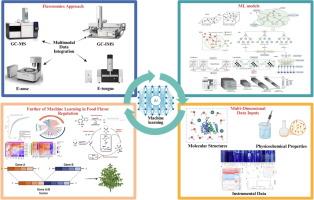Machine learning for food flavor prediction and regulation: models, data integration, and future perspectives
IF 13
1区 综合性期刊
Q1 MULTIDISCIPLINARY SCIENCES
引用次数: 0
Abstract
Background
Flavor is a central attribute of food quality, shaping consumer preferences and market performance. Traditional evaluation methods, such as sensory panels and basic assays, are often constrained by subjectivity, low throughput, and limited scalability. With the rise of high-throughput technologies and multimodal datasets, machine learning (ML) has emerged as a promising tool for deciphering and regulating complex flavor systems.Aim of review
This review examines current flavor detection techniques and the application of ML across diverse domains. It compares supervised learning models (SVM, DT), ensemble algorithms (XGBoost, LightGBM), and deep learning approaches (CNN, ANN). This review also discusses the contribution of three major data dimensions to flavor prediction, as well as future prospects in the field. ML enables precise flavor prediction, compound screening, and real-time process control. To support these tasks, researchers have developed integrated analytical systems that combine electronic nose (E-nose), electronic tongue (E-tongue), gas chromatography–mass spectrometry (GC–MS), and gas chromatography–ion mobility spectrometry (GC-IMS). Ensemble learning and deep learning models show strong performance when handling complex, nonlinear datasets. Explainable artificial intelligence (XAI) tools such as Shapley Additive Explanations (SHAP) improve model transparency by linking predictions to underlying features. ML models further enhance both prediction accuracy and generalizability. Innovations such as attention mechanisms, graph neural networks, and digital twins support dynamic flavor modulation. ML also aids in identifying key flavor compounds and genotype-phenotype relationships, accelerating breeding and formulation.Key scientific concepts of review
ML is opening up new technological avenues in flavor science, with significant potential to predict and control flavor formation mechanisms, verify product authenticity, and support the targeted design of flavor-active compounds that align with consumer expectations for sensory appeal.

用于食品风味预测和调节的机器学习:模型、数据集成和未来展望
风味是食品质量的核心属性,影响着消费者的偏好和市场表现。传统的评估方法,如感觉面板和基本分析,往往受到主观性、低通量和有限的可扩展性的限制。随着高通量技术和多模态数据集的兴起,机器学习(ML)已成为破译和调节复杂风味系统的有前途的工具。本文综述了当前的风味检测技术以及ML在不同领域的应用。它比较了监督学习模型(SVM, DT),集成算法(XGBoost, LightGBM)和深度学习方法(CNN, ANN)。本文还讨论了三个主要数据维度对风味预测的贡献,以及该领域的未来前景。ML可以实现精确的风味预测,化合物筛选和实时过程控制。为了支持这些任务,研究人员开发了集成的分析系统,结合了电子鼻(E-nose)、电子舌(E-tongue)、气相色谱-质谱(GC-MS)和气相色谱-离子迁移谱(GC-IMS)。集成学习和深度学习模型在处理复杂的非线性数据集时表现出很强的性能。可解释的人工智能(XAI)工具,如Shapley加性解释(SHAP),通过将预测与潜在特征联系起来,提高了模型的透明度。ML模型进一步提高了预测精度和泛化能力。诸如注意力机制、图神经网络和数字孪生等创新支持动态风味调制。ML还有助于识别关键风味化合物和基因型表型关系,加速育种和配方。reviewML的关键科学概念为风味科学开辟了新的技术途径,在预测和控制风味形成机制、验证产品真实性以及支持有针对性地设计符合消费者感官吸引力期望的风味活性化合物方面具有重大潜力。
本文章由计算机程序翻译,如有差异,请以英文原文为准。
求助全文
约1分钟内获得全文
求助全文
来源期刊

Journal of Advanced Research
Multidisciplinary-Multidisciplinary
CiteScore
21.60
自引率
0.90%
发文量
280
审稿时长
12 weeks
期刊介绍:
Journal of Advanced Research (J. Adv. Res.) is an applied/natural sciences, peer-reviewed journal that focuses on interdisciplinary research. The journal aims to contribute to applied research and knowledge worldwide through the publication of original and high-quality research articles in the fields of Medicine, Pharmaceutical Sciences, Dentistry, Physical Therapy, Veterinary Medicine, and Basic and Biological Sciences.
The following abstracting and indexing services cover the Journal of Advanced Research: PubMed/Medline, Essential Science Indicators, Web of Science, Scopus, PubMed Central, PubMed, Science Citation Index Expanded, Directory of Open Access Journals (DOAJ), and INSPEC.
 求助内容:
求助内容: 应助结果提醒方式:
应助结果提醒方式:


